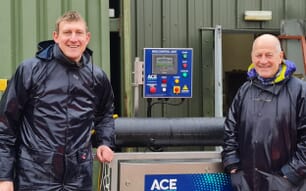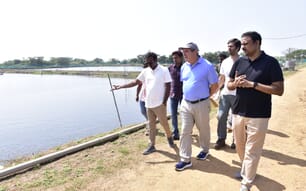Starting this year and for the first time, fishery observers are required aboard Alaska’s long line fleet of roughly 1,500 boats, most of which are well under 50 feet.
Observers have been aboard other types of Alaska fishing vessels for decades to collect data and monitor catches and bycatches; now scientists and managers want a better idea of what’s coming up on those miles of hooks and lines, no matter what the vessel size.
Small boat fishermen are clamoring to displace the observers with cameras, which are proving to be a good set of eyes. EMS has been used on large Bering Sea boats for several years, and fishery managers have grappled with how to move cameras beyond compliance functions to culling reliable research data.
“We know we can use camera technologies, and we already have it regulated and operational,” said Martin Loefflad, director of NOAA Fisheries’ Monitoring and Analysis Division of the North Pacific Observer Program at the Alaska Fisheries Science Center in Seattle.
“The challenge becomes very different when you move from ‘is industry behaving the way they are supposed to by regulation, to looking at what is actually coming up on the lines, and trying to identify and measure it, and then trying to get the data from the video into the hands of a manager so they can use it to make decisions. And therein lies some of the interesting technical challenges,” Loefflad explained, calling the new venture “our first big foray into EMS.”
That’s where the F/V volunteers come in.
“We are really dependent on the fishing industry to help us,” Loefflad said. “We are looking for folks who will work with us to take it out on their boats and be creative. To help us understand their operations, and how the camera systems can best fit into those operations so it works for everybody.”
It’s a simple operation, according to Tim Carroll, CEO of Saltwater, Inc. in Anchorage, which has been providing fishery observers in Alaska for over two decades. Test runs on EMS have been underway for a few years on longliners fishing out of Homer and Southeast Alaska, with promising results. “The main task for fishermen is to simply keep the camera lenses clean,” he said.
“The basic package is two cameras, a hydraulic sensor, a magnetic sensor a GPS sensor, and a server and a monitor so that the fishermen can see what’s going on and make sure the system is working. We have removable hard drives, so when the boat comes back to shore, we remove it and put in a fresh one. So the system can operate indefinitely,” Carroll explained.
But the EMS project goes well beyond just putting a camera and recorder on a fishing boat. There are things to tweak and adjust, Carroll said, “and each one of the different fishermen has had direct input on how that has happened.”
“We have learned so much from them about how they are fishing and how we can make this system work for them,” Carroll said. “Things like camera placement, how to adapt to various power sources, how to position the sensors to be the least intrusive and have the least impact on fishing activity as possible.”
Only a half dozen boats have carried the EMS gear so far and many more are needed before a full-fledged EMS program can be launched.
“This is a great opportunity for fishermen to shape what is arguably a new technology and a new way of collecting data, “Carroll said. “ I would encourage as many of them as possible to jump on board.”
Questions? Contact Elizabeth.chilton@noaa.gov or call Saltwater, Inc. toll free at 1-800-770-3241.
Marketing a message - When Alaska’s largest salmon fleet at Bristol Bay voted in 2006 to form and fund a state-sanctioned Regional Seafood Development Association (RSDA), the 1,865 drift netters had one main goal: to improve the quality of their fish. They are now well on their way to achieving that - last summer for the first time over half of the driftnet fish was chilled and the number will climb higher this season.
Now the BBRSDA is burnishing its brand with a big push into marketing. This summer over 3,200 US retailers signed on for Bristol Bay sockeye salmon promotions, as well as a bevy of chefs.
“We have over 80 restaurants across the country hosting ongoing dinners and events,” said Beth Poole, formerly of Cordova, the group’s first marketing director. Poole said the message goes well beyond the dinner plates.
“The goal of the dinner series is to have people know about Bristol Bay –the fishermen, the jobs, all of the family businesses that are working hard to provide this wonderful salmon, and then some of the threats that are happening with Pebble Mine. We want to make the connection between sustainable salmon and sustainable jobs,” she said.
“This is what it all comes back to for the fishermen. It’s about them being able to do their job and harvest this resource. They want them to know it’s not some big company that is benefitting, that it gets down to the individual fishermen and their small businesses that need to be sustained into the future,” Poole said.
More on RSDAs - Regional Seafood Development Associations are non-profit organizations created in 2004 by the Alaska Legislature. The purpose is for fishermen (in all fisheries, not just salmon) to work collectively toward increasing the value of their harvests in each of twelve regions designated by statute. The fishermen, who must agree to a self-tax to fund the RSDA, dictate how the money will be spent.
Salmon fishermen at Copper River/Prince William Sound were the first to avail themselves of the RSDA opportunity in 2006, voting to each pay a 1% tax on the value of their catches. Each year, that adds up to $400,000 or so from the 541 member drift fleet there.
At Bristol Bay, where salmon fishermen also voted to pay a 1% tax; the total for their RSDA tops $1 million a year.
Other regions eligible to form an RSDA are Southeast/Yakutat, Cook Inlet, Kodiak, Alaska Peninsula, Aleutian Islands, Chignik, Kuskokwim, Yukon and Norton Sound/Port Clarence.
Salmon fishermen at the Alaska Peninsula and the Yukon formed an RSDA several years ago, but neither has voted yet to fund it.
Salmon watch – It’s official: Alaska’s pink salmon catch has set a record as swarms of fish continue to come in. By Aug. 16 the statewide catch was approaching 164 million humpies, breaking the record of 161 million pinks in 2005.
On the same date the overall statewide salmon harvest had topped 211 million, meaning the 2013 Alaska catch also is on track to be a record breaker. The highest catch on record 221 million fish harvested in 2005.




